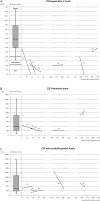Temporal Changes in the Cerebrospinal Fluid Level of Hypocretin-1 and Histamine in Narcolepsy
- PMID: 28364477
- PMCID: PMC5806580
- DOI: 10.1093/sleep/zsw010
Temporal Changes in the Cerebrospinal Fluid Level of Hypocretin-1 and Histamine in Narcolepsy
Abstract
Study objectives: To follow the temporal changes of cerebrospinal fluid (CSF) biomarker levels in narcoleptic patients with unexpected hypocretin level at referral.
Methods: From 2007 to 2015, 170 human leukocyte antigen (HLA) DQB1*06:02-positive patients with primary narcolepsy and definite (n = 155, 95 males, 60 females, 36 children) or atypical cataplexy (n = 15, 4 males, 3 children) were referred to our center. Cerebrospinal hypocretin deficiency was found in 95.5% and 20% of patients with definitive and atypical cataplexy, respectively. CSF hypocretin-1 (n = 6) and histamine/tele-methylhistamine (n = 5) levels were assessed twice (median interval: 14.4 months) in four patients with definite and in two with atypical cataplexy and hypocretin level greater than 100 pg/mL at baseline.
Results: CSF hypocretin levels decreased from normal/intermediate to undetectable levels in three of the four patients with definite cataplexy and remained stable in the other (>250 pg/mL). Hypocretin level decreased from 106 to 27 pg/mL in one patient with atypical cataplexy, and remained stable in the other (101 and 106 pg/mL). CSF histamine and tele-methylhistamine levels remained stable, but for one patient showing increased frequency of cataplexy and a strong decrease (-72.5%) of tele-methylhistamine levels several years after disease onset. No significant association was found between relative or absolute change in hypocretin level and demographic/clinical features.
Conclusions: These findings show that in few patients with narcolepsy with cataplexy, symptoms and CSF marker levels can change over time. In these rare patients with cataplexy without baseline hypocretin deficiency, CSF markers should be monitored over time with potential for immune therapies in early stages to try limiting hypocretin neuron loss.
Keywords: cataplexy; histamine.; hypocretin/orexin; narcolepsy.
© Sleep Research Society 2017. Published by Oxford University Press [on behalf of the Sleep Research Society].
Figures
Similar articles
-
The role of cerebrospinal fluid hypocretin measurement in the diagnosis of narcolepsy and other hypersomnias.Arch Neurol. 2002 Oct;59(10):1553-62. doi: 10.1001/archneur.59.10.1553. Arch Neurol. 2002. PMID: 12374492
-
Impaired histaminergic neurotransmission in children with narcolepsy type 1.CNS Neurosci Ther. 2019 Mar;25(3):386-395. doi: 10.1111/cns.13057. Epub 2018 Sep 17. CNS Neurosci Ther. 2019. PMID: 30225986 Free PMC article.
-
Hypocretin (orexin) levels in cerebrospinal fluid of patients with narcolepsy: relationship to cataplexy and HLA DQB1*0602 status.Sleep. 2002 Nov 1;25(7):733-6. doi: 10.1093/sleep/25.7.733. Sleep. 2002. PMID: 12405608
-
Symptomatic narcolepsy, cataplexy and hypersomnia, and their implications in the hypothalamic hypocretin/orexin system.Sleep Med Rev. 2005 Aug;9(4):269-310. doi: 10.1016/j.smrv.2005.03.004. Sleep Med Rev. 2005. PMID: 16006155 Review.
-
[Narcolepsy: etiology, clinical features, diagnosis and treatment].Postepy Hig Med Dosw (Online). 2012 Oct 24;66:771-86. doi: 10.5604/17322693.1015529. Postepy Hig Med Dosw (Online). 2012. PMID: 23175331 Review. Polish.
Cited by
-
Recent advances in treatment for narcolepsy.Ther Adv Neurol Disord. 2019 Sep 26;12:1756286419875622. doi: 10.1177/1756286419875622. eCollection 2019. Ther Adv Neurol Disord. 2019. PMID: 31632459 Free PMC article. Review.
-
Narcolepsy Type 1 as an Autoimmune Disorder: Evidence, and Implications for Pharmacological Treatment.CNS Drugs. 2017 Oct;31(10):821-834. doi: 10.1007/s40263-017-0464-6. CNS Drugs. 2017. PMID: 28940143 Review.
-
Reviewing the Clinical Implications of Treating Narcolepsy as an Autoimmune Disorder.Nat Sci Sleep. 2021 May 11;13:557-577. doi: 10.2147/NSS.S275931. eCollection 2021. Nat Sci Sleep. 2021. PMID: 34007229 Free PMC article. Review.
-
Melanin-concentrating hormone neurons contribute to dysregulation of rapid eye movement sleep in narcolepsy.Neurobiol Dis. 2018 Dec;120:12-20. doi: 10.1016/j.nbd.2018.08.012. Epub 2018 Aug 24. Neurobiol Dis. 2018. PMID: 30149182 Free PMC article.
-
Intermediate hypocretin-1 cerebrospinal fluid levels and typical cataplexy: their significance in the diagnosis of narcolepsy type 1.Sleep. 2022 May 12;45(5):zsac052. doi: 10.1093/sleep/zsac052. Epub 2022 Mar 7. Sleep. 2022. PMID: 35554594 Free PMC article.
References
-
- Dauvilliers Y, Arnulf I, Mignot E. Narcolepsy with cataplexy. Lancet. 2007; 369(9560): 499–511. - PubMed
-
- American Academy of Sleep Medicine. International classification of sleep disorders–third edition (ICSD-3). Darien, Illinois:American Academy of Sleep Medicine; 2014.
MeSH terms
Substances
LinkOut - more resources
Full Text Sources
Other Literature Sources
Research Materials


